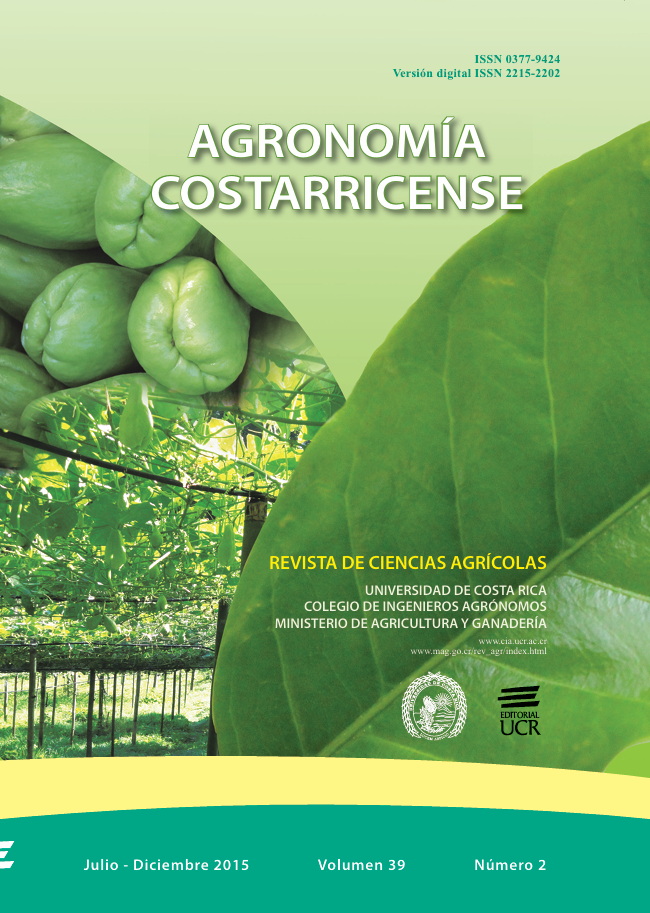Abstract
Organic amendments have been widely used to stimulate the populations of predatory nematophagous fungi (PNF) in soil; however, the use of organic amendments has produced inconsistent results in the control of parasitic nematodes. The inconsistencies have been partially attributed to the chemical composition of the organic amendments, specifically to carbon and nitrogen contents. Therefore, to know the carbon preferences of these fungi could be helpful to promote the predatory phase of the PNF in soil. The aim of this study was to determine the growth of native PNF strains from Costa Rica in diverse carbon sources. The PNF Arthrobotrys oligospora and Candelabrella musiformis were grown in artificial culture media containing the following carbon sources: cellulose, chitin, pectin, starch, and skim milk. The growth rate developed by the PNF in each one of the culture media was determined and compared. The growth rates developed by both fungal species followed the next order: cellulos e>chitin>pectin>starch>skim milk. Significant differences in the growth rates developed by the fungal strains were detected only in culture medium containing cellulose, in comparison with culture media containing other carbon sources. In culture medium containing cellulose both A. oligospora and C. musiformis grew faster with respect to the other culture media, but A. oligospora strains grew faster in comparison with C. musiformis strains. Both fungal species developed the lowest growth rates in culture media containing starch and skim milk.References
AKHTAR M., MAHMOOD I. 1996. Organic soil amendments in relation to nematode management with particular reference to India. Integrated Pest Management Reviews 1:201-215.
AKHTAR M., MALIK A. 2000. Roles of organic soil amendments and soil organisms in the biological control of plant-parasitic nematodes: a review. Bioresource Technology 74:35-47.
ANDERSON M.J. 2001. A new method for non-parametric multivariate analysis of variance. Austral Ecology 26:32-46.
COOKE R.C. 1962. Behaviour of nematode-trapping fungi during decomposition of organic matter in the soil. Transactions of the British Mycological Society 45(3):314-320.
DE HOOG G.S. 1985. Taxonomy of the Dactylaria complex IV–V. Centraalbureau Voor Schimmelcultures Baarn. Studies in Mycology 26:61-96.
DONG L.Q., ZHANG K.Q. 2006. Microbial control of plantparasitic nematodes: a five-party interaction. Plant and Soil 288:31-45.
FRENCH E.R., HEBERT T.T. 1980. Métodos de Investigación Fitopatológica. Instituto Interamericano de Cooperación para la Agricultura. San José, Costa Rica. 289 p.
GORTARI M.C., HOURS R.A. 2008. Fungal chitinases and their biological role in the antagonism onto nematode eggs. A review. Mycological Progress 7:221-238.
HAARD K. 1968. Taxonomic studies on the genus Arthrobotrys Corda. Mycologia 60:1140-1159.
JAFFEE B.A. 2004a. Do organic amendments enhance the nematode-trapping fungi Dactylellina haptotyla and Arthrobotrys oligospora? Journal of Nematology 36(3):267-275.
JAFFEE B.A. 2004b. Wood, nematodes, and the nematodetrapping fungus Arthrobotrys oligospora. Soil Biology & Biochemistry 36:1171-1178.
JAFFEE B.A., FERRIS H., SCOW K.M. 1998. Nematodetrapping fungi in organic and conventional cropping systems. Ecology and Population Biology 88(4):344- 350.
JAIRAJPURI M.S. 1990. Nematode Bio-Control. CBS Publishers & Distributors. Nueva Delhi, India. 152 p.
MALVESSI E., MOURA DA S.M. 2004. Influence of medium composition and pH on the production of polygalacturonases by Aspergillus oryzae. Brazilian Archives of Biology and Technology 47(5):693-702.
NGUYEN V.L., BASTOW J.L., JAFFEE B.A., STRONG D.R. 2007. Response of nematode-trapping fungi to organic substrates in a coastal grassland soil. Mycological Research 111:856-862.
OKA Y. 2010. Mechanisms of nematode suppression by organic soil amendments—A review. Applied Soil Ecology 44:101-115.
OROZCO A.M., ÁLVAREZ C.V., JIMÉNEZ R.A., ACUÑA N.O. 2009. Evaluación in vitro de hongos nematófagos para el control biológico de nemátodos gastrointestinales de rumiantes. Revista MVZ Córdoba 14(3):1820-1830.
PERAZA W., OROZCO M., ESQUIVEL A., RIVERA G., CHAVERRI F. 2011. Aislamiento e identificación de hongos nematófagos nativos de zonas arroceras de Costa Rica. Agronomía Mesoamericana 22(2):233- 243.
PERSSON C., OLSSON S., JANSSON H-B. 2000. Growth of Arthrobotrys superba from a birch wood resource base into soil determined by radioactive tracing. FEMS Microbiology Ecology 31:47-51.
PRAMER D. 1964. Nematode-trapping fungi. Science 144(3617):382-388.
QUINN M.A. 1987. The influence of saprophytic competition on nematode predation by nematode-trapping fungi. Journal of Invertebrate Pathology 49:170-174.
RUBNER A. 1996. Revision of predacious hyphomycetes in the Dactylella-Monacrosporium complex. Centraalbureau Voor Schimmelcultures Baarn and Delft. Studies in Mycology 39:1-134.
SÁNCHEZ C.M. 2000. Manual de prácticas de Microbiología industrial para las carreras de IBQ y QBP. Escuela Nacional de Ciencias Biológicas. Instituto Politécnico Nacional. México, D.F. 65 p.
SATCHUTHANANTHAVALE V., COOKE R.C. 1967. Carbohydrate nutrition of some nematode-trapping fungi. Nature 214(15):321-322.
SCHOLLER M., RUBNER A. 1994. Predacious activity of the nematode-destroying fungus Arthrohotrys oligospora in dependence of the medium composition. Microbiology Research 149(2):145- 149.
SIDDIQUI Z.A., MAHMOOD I. 1996. Biological control of plant-parasitic nematodes by fungi: a review. Bioresource Technology 58:229-239.
SOTO N., DE OLIVEIRA J., VEGA R., MONTERO D., VARGAS B., HERNÁNDEZ J., OROZCO C. 2011. In-vitro predatory activity of nematophagous fungi from Costa Rica with potential use for controlling sheep and goat parasitic nematodes. Revista de Biología Tropical 59(1):37-52.
STIRLING G.R. 1991. Biological control of plant-parasitic nematodes. CAB International, Wallingford, UK. pp. 101-152.
SWE A., JEEWON R., POINTING S.B., HYDE K.D. 2009. Diversity and abundance of nematode-trapping fungi from decaying litter in terrestrial, freshwater and mangrove habitats. Biodiversity Conservation 18:1695-1714.
TABARANT P., VILLENAVE C., RISEDE J.M., ROGER J.,THURIES L., DOREL M. 2011. Effects of four organic amendments on banana parasitic nematodes and soil nematode communities. Applied Soil Ecology 49:59-67.
TIKHONOV V.E., LOPEZ L.V., SALINAS J., JANSSON H.B. 2002. Purification and characterization of chitinases from the nematophagous fungi Verticillium chlamydosporium and V. suchlasporium. Fungal Genetics and Biology 35:67-78.
VILLENA G.K., GUTIÉRREZ C.M. 2003. Biopelículas de Aspergillus niger para la producción de celulasas: algunos aspectos estructurales y fisiológicos. Revista Peruana de Biología 10(1):78-87.
WATANABE T. 1937. Pictorial Atlas of soil and seed fungi: morphologies of cultured fungi and key to species 2nd edition. CRC Press, USA. pp. 39-190.
YANG J., YU Y., LI J., ZHU W., GENG Z., JIANG D., WANG Y., ZHANG K-Q. 2013. Characterization and functional analyses of the chitinase‑encoding genes in the nematode‑trapping fungus Arthrobotrys oligospora. Archives of Microbiology 195:453-462.


